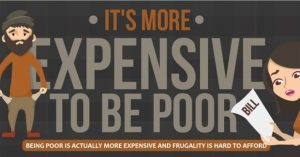The word “poor” has an overwhelming negative connotation. In many societies, it is thought to be the exact opposite of what one strives for. To have money is thought to provide the ability to live comfortably, from where you live to what you eat, and even what you’re capable of doing given your resources.
When you think of being poor, you likely don’t envision an expensive lifestyle. Why would you? Though it seems to defy logic, there’s really a very simple explanation for why living poor is actually pretty expensive.
If you think about it, people who are poor likely live paycheck to paycheck. This means it’s probably impossible for them to afford buying more than one thing at a time. For instance, buying in bulk can be a big money saver in the long run, especially for staple items like toilet paper, which costs 5.9 percent more when purchased individually. Another example would be taking advantage of sales, like, again, toilet paper. A store may be offering a two-for-one deal, but because a poor person’s income is time-sensitive, they may always be buying their product at full price.
The poor need such thrifty strategies to save, and yet the cycle they’re stuck in doesn’t allow for this, points research conducted by University of Michigan professor Yesim Orhun and Ph.D. student Mike Palazzolo. The team used panel data on more than 100,000 American households over the course of seven years for their findings, tracking purchases of toilet paper — a steadily consumed and non-perishable item.
While you may be thinking this is just a small realization about some household items, it’s really the backbone of the idea that it’s expensive to be poor, or, rather that having more money gives people the ability to pay less for things.
“You can create a poverty trap even around the toilet paper that we study,” explains Orhun. Middle-class consumers have a different approach, she says. “They buy when the price is right and wait when the price isn’t. But poor people don’t have that luxury.”
Another way of looking at this would be quality. Because higher quality things tend to cost more, someone without the funds may opt for low-quality items, or used items. An example would be buying a cheap car. Because it’s been around the block, it’s more prone to breakdowns and higher maintenance costs. The same can be said for computers, washing machines, refrigerators, and more.
To really drive the point home, look at it this way: if you’re able to afford a Costco membership, you are given the opportunity to buy super cheap items in bulk. If you have Amazon Prime, you can save on various costly items. If you can afford the higher quality garb, you might be able to wear it longer, and therefore not have to keep updating your wardrobe. The list could truly go on, and on…
Want to see an even more in-depth breakdown? Check out this infographic that will give you the some recommended steps for saving more if you are stuck in the paycheck to paycheck cycle. You can begin by calculating your monthly bills, and then creating a budget.
 RSS Feed
RSS Feed















 April 19th, 2017
April 19th, 2017  Awake Goy
Awake Goy 
 Posted in
Posted in  Tags:
Tags: 













